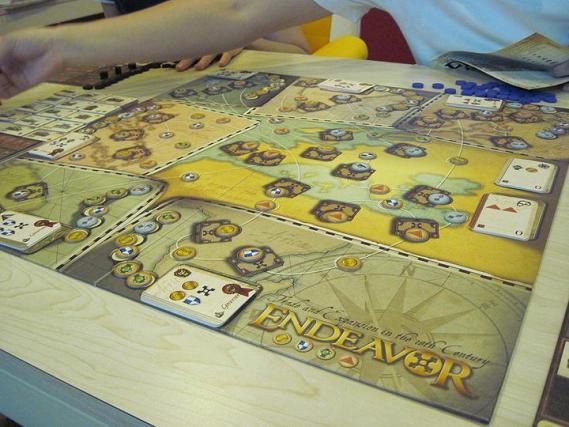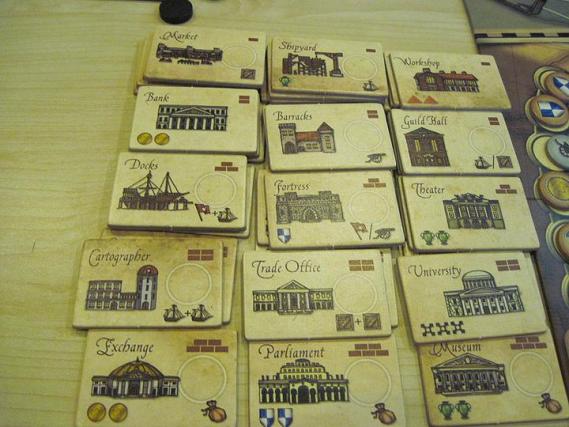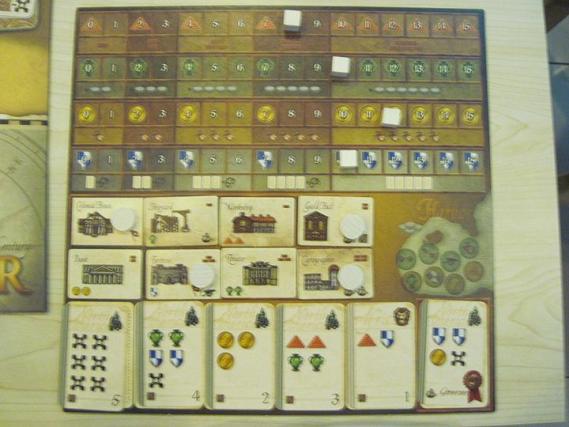
Endeavor was originally on my radar because a Kiwi QT3 friend heavily touted it on the forum as a New Zealander-designed game. It also helped that quite a few QT3ers expressed favorable opinions on the game, which is quite unusual given how strongly the crowd there tends to veer over to the Ameritrashy side. That was last year however and it was only when I went back to check Hiew’s blog that I remembered that Sean promised to buy this based on our comments there.
The theme of the game doesn’t seem particularly inspiring to me. How many Euro games are there already that involve the European nations sending ships out to the rest of the world? The mechanics aren’t particularly innovative either but as Hiew mentioned, this game scores bonus points both for being extremely streamlined and hence easy to pick up and for its very effective graphic design. Many games these days like to use icons instead of text to denote game effects, no doubt because it saves space and to make the game language-independent, this can sometimes make a game difficult to learn. That’s not the case at all for Endeavor.
Some highlights:
- The game lasts for a fixed seven turns but there is no turn marker. This is because each player is sure to get a new building for free each turn. So when you fill the last building space on your player mat, you know it’s the last turn. Neat!
- There’s some engine-building in here. You have a bunch of tracks on your mat. As you upgrade stuff, this not only scores points for you but, together with the increased number of buildings you have, allows you to perform more actions in a round.

- There’s a deck of slavery cards in Europe, which as far as I can tell, can let you advance down the building track very fast, giving you access to higher rank buildings. But you get burned if someone progresses all the way down the other deck of cards in Europe and takes the slavery abolition card. Sean was the only one of us who took a slavery card and he did indeed get burned by it. I don’t think any of us are going to take any slavery cards if we ever play this again.
- Apparently drawing the slavery abolition is supposed to be non-trivial since one player needs to control five cities in Europe and that is supposed to be the most hotly contested area. In our game, Chee Wee dominated Europe early on and was very trigger-happy about using the costly attack action to maintain that dominance so he drew that card without much problem.
- I was very surprised to find that I won this game. I actually thought that I was in last place around the middle of the game. Occupying cities and controlling the links are worth a lot of points but I had barely any cities in the mid-game. Instead I did something that everyone thought was pretty dumb. I shipped a lot, and almost singlehandedly opened the route to North America. I did not fight at all until the last couple of turns. Due to all the tokens I collected from shipping, I managed to advance to the end of three of the four tracks, maxing out my action potential.

- Due to my huge lead in shipping in North America, others were reluctant to help me open the route because I was sure to get the governor card for the colony. But when I did eventually open access to the area, this also meant that I had next to no competition for the cards there and could draw them at my leisure. Out of the six cards on my mat at the end of the game, five were from North America. I haven’t seen all of the decks but I suspect that the six points value of the last card in that area is the highest of any in the game.
- Once again, I benefited from being perceived as not being in a strong position up until the end of the game and also because I’m not considered a strong player generally. Chee Wee was perceived as the leader for most of the game and I think he saw Sean as his greatest threat and used a lot of attack actions on him. I only used the attack actions near the end of the game to snag the cities and the links that were worth the most points to me. By that time, most of the others didn’t have enough people left to do something about it.
- We joked that this is the rare Euro game that is all about fighting instead of peaceful development. It’s a costly action since you effectively need to spend three workers for each attack, compared to two workers for occupying and shipping and just one worker for drawing cards. But cities and links are worth guaranteed points. I think the attack actions are especially valuable late in the game when you can use them to break other players’ links even if you can’t gain them yourself. It does seem unusually confrontational that you can deliberately deprive someone of points like this.
Overall, I find Endeavor to be a good and solid Euro. I do find it a bit odd that there is just one map. It seems obvious to me that, like Hansa Teutonica, they should have made a map for three to four players and another map for five players. In our four-player game, no one made it to India. I imagine the map would be even emptier with three players. Apparently there are now variants allowing this to be played with two players, but I’d have to see it to be convinced.
Leave a Reply